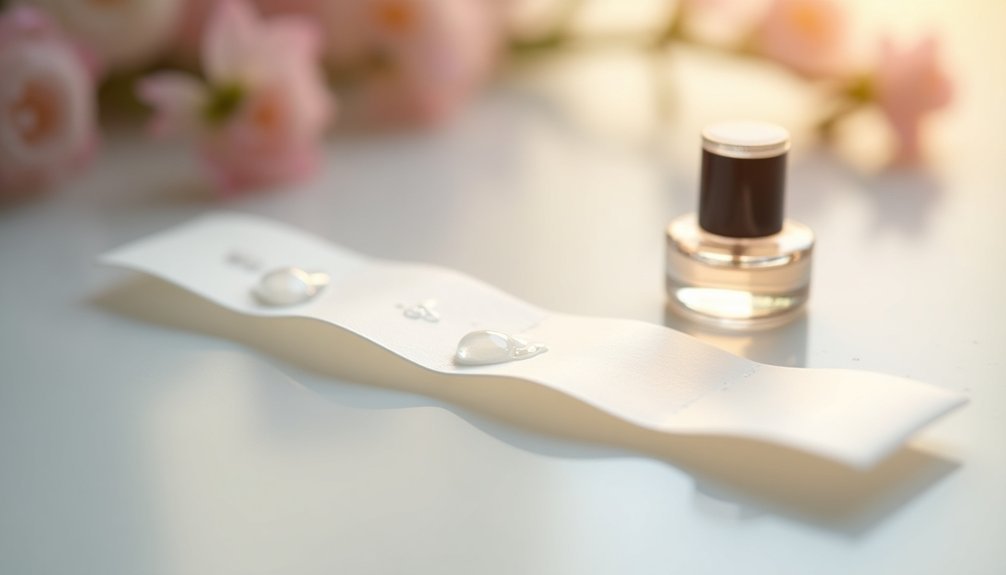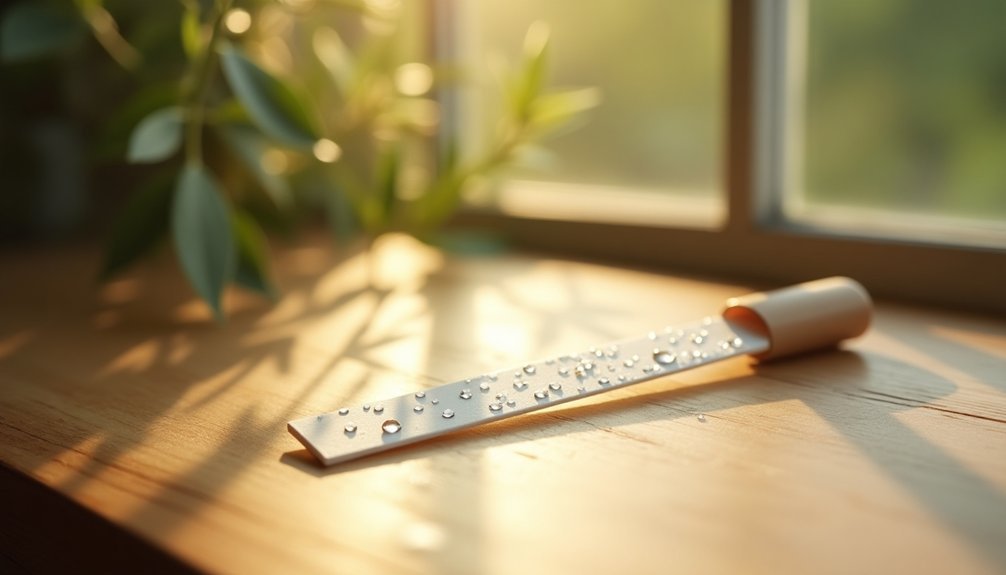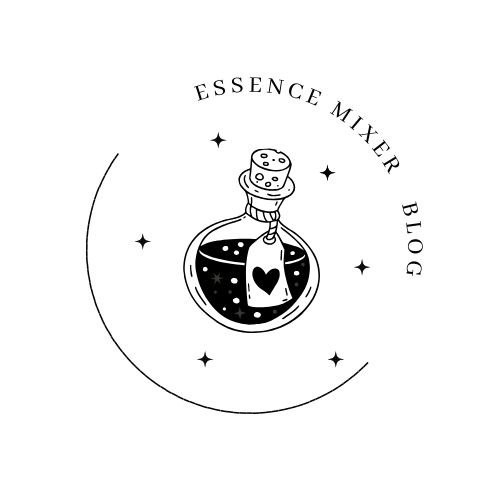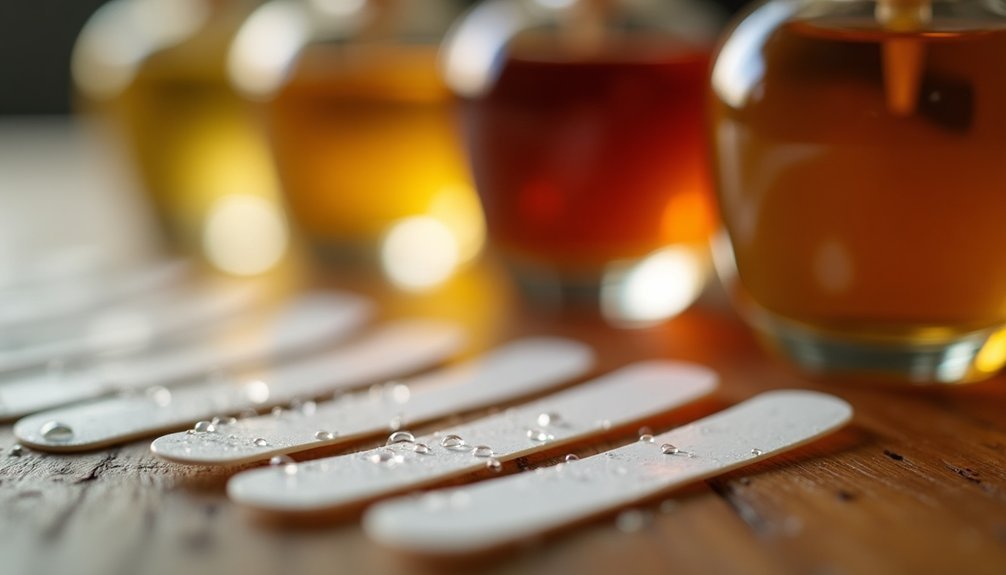When you test fragrances on paper strips, you'll need to let them rest overnight to reveal their true character. Initially, you'll smell the fleeting top notes, but the heart and base notes take several hours to fully develop. The overnight resting period allows volatile components to dissipate gradually, uncovering subtle layers and complex interactions between ingredients. Understanding these deeper scent transformations holds the key to making informed fragrance choices.
The Science Behind Fragrance Evolution on Test Strips

When you place a fragrance on a test strips, you're setting in motion a complex process of evaporation and molecular interaction that reveals the true nature of the scent.
The paper's unique absorption properties interact with the fragrance compounds, creating a controlled environment where volatile components gradually dissipate.
You'll notice that fragrances evolve more quickly on test strips than on your skin, making them excellent tools for understanding a scent's complete character.
As the top notes fade away overnight, you'll discover deeper, more complex layers that weren't initially apparent. This progression helps you assess how long the fragrance will last and how it might perform on your skin.
Understanding Top, Heart, and Base Notes Development
You'll notice how fragrance test strips reveal distinct phases of scent development, starting with the quick-evaporating top notes in the first hour.
The heart notes emerge as the top notes fade, typically taking 2-4 hours to fully express their character on the strip.
After leaving your test strip overnight, you'll experience the true base notes that form the fragrance's foundation, giving you a complete understanding of how the scent evolves over time.
Note Evolution Timeline
Testing fragrance strips effectively requires understanding the timeline of how scents evolve overnight. During your perfume test, you'll notice that top notes emerge immediately but only last up to 2 hours.
As these initial scents fade, heart notes begin developing within 30 minutes to 2 hours, requiring overnight observation to reach their full expression.
The note evolution timeline continues as base notes gradually surface after several hours, taking up to a full day to completely develop on the test strip.
This extended process reveals how the fragrance's intensity and complexity change over time. By allowing your test strips to develop overnight, you'll gain a thorough view of how each layer of scents shifts and interacts, providing accurate insights into the fragrance's complete character and staying power.
Scent Layering Phases
A successful fragrance evaluation relies on understanding how scent layers develop and interact over time.
When you test a fragrance, you'll experience distinct scent layering phases that unfold like chapters in a story.
The journey begins with top notes, which hit your senses immediately and last up to a few hours, similar to the initial burst of an essential oil.
As these fade, heart notes emerge, revealing the fragrance's true character and personality for several hours.
Finally, base notes surface, providing depth and staying power that you'll notice most prominently after extended wear.
This complex evolution is why overnight testing is essential – it gives you the complete picture of how these three layers blend and transform, ensuring you understand the fragrance's full development from start to finish.
Time-Based Changes in Scent Perception

You'll notice significant changes in your fragrance test strips when you let them rest overnight, as scents evolve differently on paper than they do on skin.
The extended resting period helps you detect subtle notes that weren't apparent during the initial spray, revealing the true character of each fragrance layer.
Scent Evolution Phases
When fragrance test strips reveal their secrets over time, you'll discover a fascinating journey through distinct aromatic phases. As you observe the scent evolution phases, you'll notice how top notes quickly fade while base notes emerge more prominently, creating a dynamic olfactory experience.
You'll find that leaving your test strips overnight provides essential insights into how fragrances truly develop. While scents may linger longer on paper than skin, this extended observation period helps you understand the fragrance's complete character.
Through the maceration process, you'll witness how different ingredients interact and transform, offering a more accurate picture of the final aroma. This overnight testing method lets you evaluate both the longevity and tenacity of the fragrance, helping you make better-informed decisions about a perfume's overall performance.
Notes Reveal Over Time
Throughout the testing process, fragrance strips gradually reveal layers of complexity that transform your initial impressions into deeper olfactory insights. As you wait overnight, the volatile compounds evaporate, allowing you to experience how the essential oils and other components interact and develop.
| Time Period | Scent Development |
|---|---|
| Initial | Top notes dominate |
| 2-3 Hours | Heart notes emerge |
| 6-8 Hours | Base notes surface |
| Overnight | True character revealed |
You'll discover that notes reveal over time in ways that aren't apparent during your first sniff. By recording these changes from application to the next day, you'll better understand the fragrance's complete personality. This methodical observation helps you determine whether the scent will complement your skin chemistry and maintain its appeal throughout daily wear.
Benefits of Overnight Evaluation Methods
Testing fragrance strips overnight reveals essential insights that immediate assessments often miss.
You'll discover how fragrances evolve over time as their components interact, exposing the true character of each scent.
This extended evaluation period helps you identify subtle base notes that aren't apparent during initial testing.
Impact of Environmental Factors on Strip Testing

Environmental conditions play an essential role in how fragrance strips perform during evaluation.
You'll notice that temperature and humidity considerably affect how scents absorb into the paper and evaporate over time. When you're testing fragrances, these environmental factors can either enhance or diminish the accuracy of your results.
As you conduct your evaluations, you'll find that the interaction between the fragrance and paper strip varies based on these conditions.
Temperature changes can accelerate or slow down the evaporation process, while humidity levels influence how the scent molecules bond with the strip material.
That's why it's vital to maintain consistent testing conditions when possible. By monitoring these environmental factors during overnight testing, you'll get more reliable and comparable results for your fragrance assessments.
Professional Perfumery Testing Techniques
When conducting professional fragrance evaluations, you'll need to incorporate overnight testing as a fundamental technique. This method allows you to assess how scents develop and transform over time, particularly the emergence of base notes that aren't immediately apparent.
As you compare multiple fragrances, you'll find that fragrance test strips left overnight reveal essential performance characteristics. You can identify longevity issues, detect unexpected scent progressions, and spot potential flaws that might surface after extended wear.
While skin testing remains important, strip testing provides a controlled environment for side-by-side comparisons. Keep in mind that scents may evolve differently on strips versus skin, so you'll want to take into account both methods for a thorough evaluation.
This extended testing period guarantees you're making informed decisions about fragrance quality and performance.
Frequently Asked Questions
What Is the 30 50 20 Rule for Perfume?
You'll find the 30-50-20 rule guides perfume composition, where 30% makes up the initial top notes, 50% forms the middle heart notes, and 20% creates the lasting base notes.
What Happens if You Apply Perfume at Night?
When you apply perfume at night, you'll get better fragrance development as it mixes with your skin's natural oils, resulting in a longer-lasting, more nuanced scent by morning. It'll also settle more effectively overnight.
Why Do You Have to Let Perfume Sit?
You'll want to let perfume sit because it allows the fragrance notes to blend together properly, develops a more accurate scent profile, and gives time for the ingredients to properly macerate and integrate.
How to Use Fragrance Test Strips?
Label the strip's wide end, dip the narrow end in fragrance, and sniff from 3 inches away. Make notes on the scent, then check again after an hour. Use coffee grounds between tests to reset your nose.
In Summary
You'll get the most accurate impression of a fragrance by letting test strips rest overnight. This allows the perfume to move through all its stages – from bright top notes to rich base notes – just as it would on your skin. During this time, you're able to experience how the scent truly develops and settles, helping you make a better-informed decision about which fragrances truly suit your preferences.





Leave a Reply